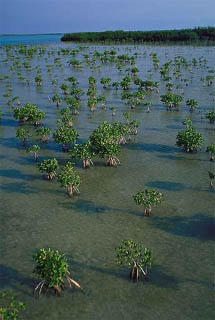Urban development is a major threat to mangrove habitats.

Due to the increasing pressure from rapidly expanding development along the coast of Florida, it is critical that mangrove habitats are protected from further destruction. Mangroves, seagrass beds, and coral reefs are all dependent upon one another, providing habitat for many aquatic plants and animals including those that are endangered and threatened. Mangroves also provide shoreline stability and protection from storm surge and erosion. These roles all support the local economies of many south Florida communities.

Pressure to destroy remaining mangrove habitat is increasing due to the continued urban development along the coasts of Florida. Currently, millions of tourists visit each year and large numbers of people move to Florida each day, placing Florida third behind California, and Texas in numbers. Residents as well as tourists add to the increasing pressure to develop shorelines.
Conservation Efforts
The Mangrove Trimming and Preservation Act was enacted in the state of Florida to regulate the alteration of mangroves.

Legislation on state and local levels has been enacted, protecting mangroves from direct human damage. In 1996, the Florida Department of Environmental Protection (FDEP) implemented the Mangrove Trimming and Preservation Act. This Act regulates the trimming and alteration of mangroves while also banning the use of herbicides and other chemicals used to defoliate mangroves. Mangroves cannot be removed, trimmed, or disturbed without a permit from the Florida Department of Environmental Protection.
Other preservation efforts have included mangrove replenishment initiatives. This consists of the determination of the causes of mangrove loss followed by the removal of those causes. Within 15-30 years mangrove habitat can once again become well-established if conditions are suitable. However, if seeds or propagules cannot reach the site, mangroves may be successfully established through replanting seedlings.
Glossary terms on page:
- storm surge: water pushed to the shore by the force of tropical storms or hurricanes, resulting in increases of 15 feet or more over the mean water level.
- erosion: the wearing away of soil, rock, and sediments, etc. by the action of wind, rain, and other weather-related elements.